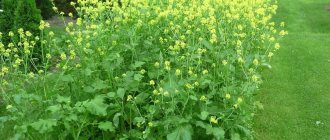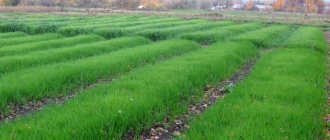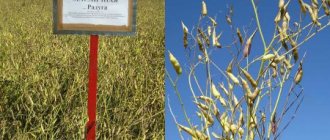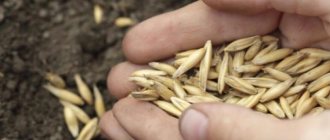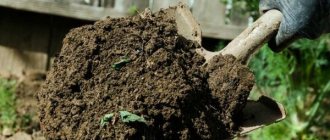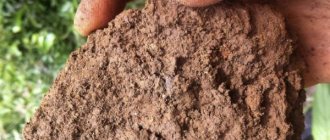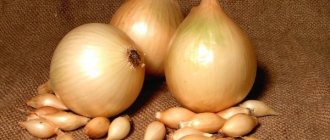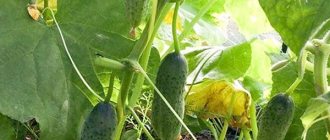Category: Siderates Reading time: 9 min · Views: 2,174
Green manure is necessary for soil fertility and increasing harvest from the site. Green manure also plays an important role in structuring the soil, attracting soil microorganisms and earthworms. Buckwheat as a green manure began to be used relatively recently, when scientists studied all its properties. Let's look at the benefits of buckwheat and why it is often used as green fertilizer in garden plots.
Properties of green manure
The soil is a unique biosystem in which various natural structures are harmoniously combined - microorganisms, microelements, oxygen, water, etc. In order for the soil to be fertile, it is necessary to replenish depleted nutrients, attract soil microorganisms and regularly moisten and loosen the soil. Green manures (or green fertilizers):
- loosen the earthen lump;
- attract earthworms;
- act as a drainage system;
- regulate air permeability and moisture permeability of the soil;
- saturate the soil with microelements - nitrogen/potassium/phosphorus.
Buckwheat is distinguished by a branched and powerful root system, which is a fertile nutrient medium for biological organisms. Also, a developed root system keeps the fertile layer from being washed away by spring waters and heavy rains, strengthens loose soil and loosens loams and clay soils. The root system of buckwheat can reach one meter in depth.
The roots of buckwheat grow wider and deeper, suppressing the development of weed root systems around them. The above-ground vegetative mass of buckwheat prevents the development of weeds from seeds, depriving them of solar energy. Therefore, experienced gardeners always use green manure crops to solve many problems, including weed control.
Description
Sowing buckwheat is a herbaceous plant with stem heights up to 1 m:
- roots - taproots;
- inflorescences – loose, white-pink;
- The fruits are triangular nuts.
The plant produces excellent buckwheat honey with a spicy aroma. Medicines and buckwheat flour are produced from the seeds.
Buckwheat is a record holder for the speed of vegetation, therefore, with the right approach to cultivation, it can produce up to 3 harvests of invaluable green fertilizer in 1 season. The roots of the plant structure the soil, and the plant residues, as they rot in the ground, enrich them with organic substances (potassium, phosphorus).
Features of buckwheat
The developed root system of buckwheat is one of the advantages of the plant as a green manure. However, the culture also has a significant drawback - it requires heat and the absence of strong winds. Since buckwheat is native to India, this plant was formed in a humid, warm climate.
Therefore, in northern latitudes, buckwheat grows very reluctantly and has a capricious disposition. Despite these disadvantages, the crop grows well in the summer. In the southern regions, this green manure can be sown and grown three times before frost.
However, this plant does not tolerate not only cold, but also too high air temperatures. These characteristics are characteristic of central Russia. In unsuitable conditions, buckwheat develops poorly and poorly gains green mass.
In favorable conditions, buckwheat develops very quickly and gains green mass. And the branched, powerful root system serves as a bait and breeding ground for beneficial soil bioorganisms.
The benefits of buckwheat as green manure
During decomposition, the root system of buckwheat releases organic acids that are important for the dissolution and absorption of phosphorus by plants. These are natural chelates that ensure the fastest, most productive supply and absorption of micronutrients by the roots of garden crops.
If you sow buckwheat as a winter green manure, in the spring you don’t have to make efforts to dig up the area for planting garden crops.
For high-quality absorption of phosphorus compounds from the soil, a balanced acid-base balance is required. When the balance shifts to the alkaline side (or neutral indicator), phosphorus compounds are very poorly absorbed by the roots. Phosphorus starvation leads to a noticeable decrease in the fertility of the site: fruit ovaries die, they grow tasteless and are not preserved until spring.
Buckwheat is plowed into the ground and used as mulch or compost heap filler.
The root system of buckwheat works as a phytosanitary site; it is used for intercropping between cereal crops. Since the roots of cereals are often affected by rot, sowing buckwheat disinfects and disinfects the soil after them.
Honey plant
Buckwheat has one more useful property - it is an excellent honey plant. Attracting bees to the site solves the issue of high-quality pollination of fruit trees and berry bushes.
Farmers recommend sowing buckwheat green manure in flower beds and near vineyard trunks. The flowers attract bees, which will also pollinate the vineyard. The root system and dense vegetative cover protect the soil from drying out. Buckwheat green manure is also planted between perennial garden plants to replenish nutrients in the fertile soil layer: perennials draw out useful microelements and deplete the soil.
Disadvantages of buckwheat
In addition to intolerance to cold and strong winds, this crop has a number of other disadvantages. Buckwheat is a moisture-loving plant and cannot tolerate a lack of moisture, so in dry summers its benefits are minimal.
To maintain optimal moisture levels, it is recommended to use a sprayer. The branched root system often intertwines with each other, creating a certain inconvenience when processing the area.
Buckwheat does not tolerate excessive moisture or lack of moisture, so watering should be moderate and regular.
Also, this plant as a green manure is not suitable for all garden crops. Therefore, before sowing, it is recommended to find out which garden plants buckwheat conflicts with. Farmers recommend using buckwheat as green manure before sowing potatoes, cucumbers, tomatoes and any root crops. It is also favorably treated with garden strawberries and greens (celery, dill, sorrel). Vineyards, fruit trees, and berry bushes love buckwheat.
Sowing
The best time for sowing buckwheat green manure is May. The land in central Russia has time to warm up, and the sun's rays do not heat the air. Sow buckwheat seeds thickly to form a dense layer of green mass. Most green manure crops are already incorporated into the soil in May, while buckwheat is just beginning to be sown.
How deep should seeds be planted in the soil? On chernozems they can be planted deeper - up to 6 cm. On dense clay soils, they should not be deepened too much; three centimeters is enough. How densely should grains be sown? 200 g of raw materials are used per hundred square meters of prepared area.
For green manure, unroasted buckwheat seeds are used, which are sold in gardening stores. The color of the beans should be green, not brown.
Do I need to cover the sown seeds with soil? Buckwheat is usually sown before rain, after which the seeds are covered with the necessary layer of soil. Therefore, you should not specifically sprinkle the seeds with soil.
However, on very heavy soils, sowing rules change. First, you need to prepare the ground - break up dense pieces of the earthen clod. Then seeds are sown into the prepared soil, which are sprinkled with soil with the back of the rake. Finally, the sown area is well watered.
Sowing buckwheat green manure three times per season will drive wheatgrass away from the site for a long time.
Is it necessary to remove the husks from buckwheat grains? This should not be done, since the husk protects the grains from sunburn.
When can crops be planted after cutting green manure? It is recommended to pause for 2-3 weeks and then start sowing. The duration of the pause is related to the moment the soil absorbs nutrients from the rotted mass.
Autumn sowing
What to do with buckwheat sown immediately after harvesting on the site? There are several options for using green manure crops after gaining green mass:
- leave for the winter without cutting;
- embed into the soil.
Green shoots die with the onset of winter cold, but perfectly enrich the earth with organic matter. After the snow melts, the seeding area is completely ready for planting garden crops: it is enriched with all essential nutritional components. The buckwheat root system remaining in the fertile layer acts as drainage and is a complete food for soil microorganisms. You can also mow the green mass and leave it as mulch.
We advise you to read: We sow green manure in the fall.
The second option is to embed green mass into the ground. However, experienced gardeners do not recommend digging up an area sown with buckwheat due to the ineffectiveness of this method. Turning over layers of earth creates unfavorable conditions for the survival of soil microorganisms that end up on the surface. Digging with a spade bayonet is used to destroy pest larvae, but not for green manure crops.
Due to the death of the biological environment, high-quality breakdown of the green mass of plants is impossible: it rots and is not processed. Therefore, the best option for autumn sowing of green manure buckwheat is mulching. Buckwheat rotted on the surface of the earth will bring much more benefits to the soil than embedded in the soil to the depth of a spade.
Growing technology
The first step is to know exactly what the air-water balance is in a particular area. It’s good if you had to deal with a long-familiar field, the “character” of which has been studied to the smallest detail.
The task becomes more complicated if you plan to sow soil that has not yet been put into use: any gardener knows that even on the same site, not only the temperature of the layer can be different, but also the depth of the water. Let’s not forget about such a factor as microflora - it happens that in the deep layers there are often rotting roots from trees cut down long ago, which attracts harmful insects.
After making sure that the site is completely ready, you need to decide exactly which plants will be used as the main ones and find out how compatible they are with buckwheat.
For which crops is it best to use?
Buckwheat itself is considered the best predecessor for almost all garden species : potatoes and tomatoes, cucumbers and strawberries. Carrots and beets won't mind either.
In this way, you can prepare the soil for planting greens - dill with sorrel, celery with parsley, as well as spicy cumin and fennel.
Buckwheat is effective even before planting fruit bushes and trees.
The use of this plant before sowing with the participation of grains is allowed only on loose and well-groomed soils.
When and how to sow green manure
After all the calculations, it’s time to find out how green manure is grown in practice, as well as when to sow them, and when is the best time to bury such a valuable plant as buckwheat.
For sowing, the moment is selected when the frosts have finally receded and the soil has warmed up at least 9-10 cm in depth (usually mid-May).
If the air temperature remains stably above +10, you can proceed:
- a flat cutter or cultivator passes through the area, the knives of which are set in a wide row of 10-15 cm;
- seeds are planted at 3-5 cm (for heavy soil) or at all 6 cm (for well-groomed soil). The consumption rate for removing weeds is from 10 to 15 g/1 sq. m (works out at 1-1.5 kg per hundred square meters);
- the crop is rolled with a roller. In the garden, you can even get by with the back of a rake.
Quick buckwheat fertilizer
Adding cut vegetative mass to compost does not bring quick results, since the fertilizer matures very slowly. To get good fertilizer for your garden in a short time, you need to make liquid green fertilizer.
To do this, a plastic container (barrel) is loaded one third with cut green mass, and the remaining space is filled with settled water. After a couple of weeks, the fertilizer is fully matured, and it is used for watering garden crops at the root or by spraying.
Liquid fertilizer contains the same nutritional components as green matter rotted in the ground.
When is the best time to cut buckwheat? As soon as the plant blooms, it is immediately mowed down. At this stage of development, buckwheat decomposes best and releases useful substances to the soil or water. Flowers on buckwheat will appear literally a month and a half after sowing, so do not miss the right time. The timing of flowering depends on weather conditions: the warmer the weather, the faster the flowers will appear.
How long does buckwheat bloom before the seed pod appears? The flowering period lasts 30-40 days; it is at this time that mowing is carried out. However, in humid, warm climates, it is recommended to mow sooner, because the seed pods may form suddenly. As soon as the first white flowers become noticeable, experienced gardeners cut off the entire vegetative mass.
Buckwheat husk
Buckwheat husks are an excellent mulching agent; they are harvested after harvesting. Husks are used for mulching any garden crops - fruit or ornamental. The husk perfectly retains soil moisture, protects against weathering and overheating of the soil. In winter, husk mulch will protect the soil and plant roots from freezing, ensuring a stable temperature inside the fertile layer.
In summer, buckwheat husks will save row spacing and prevent weed seeds from germinating, as it deprives them of solar energy. The advantages of using husks as mulch include regular replenishment of the soil layer with nutrients: after each rain, microelements dissolved in water will enter the soil.
Buckwheat husk mulch looks very decorative, covering bare areas of the ground, ridding flower beds of weeds.
The husk deserves special value because of its ability to positively influence the health of the soil layer and free it from various pathogenic microorganisms. The husk absorbs excess moisture, preventing mold and rot.
How to provide proper care
Buckwheat is an unpretentious plant. It has a short growing season and does not even need watering in regions with a moderately rainy climate. If the summer is dry, then of course it is important to shed and spray the soil once a week, but not to overdo it. Too much water is just as bad for the soil as drought.
It is important to periodically inspect the seedlings once every 10 days. With the right approach to cultivation, buckwheat usually begins to bloom within a month. Then, after 2-3 days, the color moves to the lateral processes. The plant blooms from 3 weeks to 40 days, depending on the variety. It is in warm zones that agronomists manage to plant buckwheat 3 times per season in order to get rid of wheatgrass (the main weed of fields and vegetable gardens) for several years to come.
Herbalist
It’s not for nothing that buckwheat is called a herbal medicine: it has no common diseases with garden crops. After sowing buckwheat, the soil is completely healed of harmful microorganisms, and the seedlings become resistant to various diseases.
Root rot is especially dangerous and destroys many healthy outdoor garden plants. Mycological studies of the soil after growing buckwheat showed a significant decrease in the population of fungal and other pathogenic organisms.
The wireworm will leave the potato field after cultivating buckwheat crops on it. This is achieved without the use of powerful chemicals that repel parasites.
Buckwheat green manure is also recommended to be grown in greenhouses to increase soil fertility and disinfect it.
Scientists have long been looking for ways to cultivate plants without the use of agrochemicals, and buckwheat ranks high on the list of environmentally friendly and safe green fertilizers.
An environmentally friendly harvest is a top priority facing the world's scientists. Only green fertilizers can provide humanity with safe gardening products. Plant fertilizers increase the formation of humus in the soil, and chemical fertilizing reduces the content of soil microorganisms due to the increased mineralization of the earth coma.
Bottom line
Buckwheat as a green manure is excellent for replenishing soil fertility; it is capable of reviving severely depleted soils. The plant quickly sprouts, develops a dense green mass, and forms a branched root system.
The greatest benefits from sowing buckwheat are in summer and late autumn. Spring sowing of the crop is possible only in May, when the soil is sufficiently warmed by the sun. Earlier spring sowing can lead to the death of sprouts due to unexpected temperature changes, which the plant does not like.
In addition to replenishing the soil with nutrients, buckwheat green manure structures it and improves its mechanical properties - moisture permeability, saturation with oxygen molecules.
For which crops to use?
This green manure is optimally suited for use in almost all plant families except buckwheat (for example, rhubarb, sorrel, etc.). It is an excellent precursor for many vegetable crops, including carrots, cucumbers and even strawberries. Also, as mentioned earlier, buckwheat will be an excellent fertilizer before planting shrubs and fruit trees, because it creates air exchange at a depth of 2 meters and structures the soil.
If you want to sow grain, then the soil must be soft and loose. Separately, it is worth noting the good interaction of this kind of green manure with herbs: sorrel, dill, caraway, celery and parsley. Many gardeners advise planting buckwheat with cabbage. But it is better not to use buckwheat near potatoes and oats.
